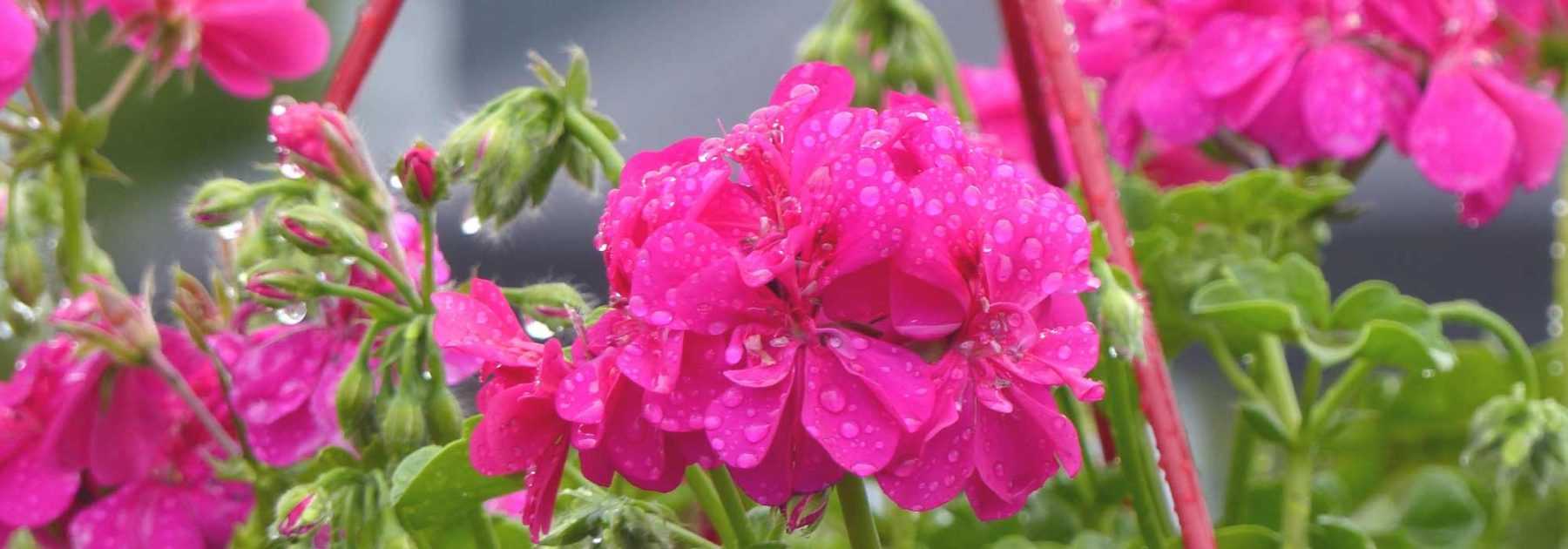
Pelargonium, Geranium: Planting and Growing
Contents
The Geranium in a Nutshell
- The pelargonium offers a long and generous flowering, for a large part of the year, from May until the first frosts
- Always beautiful and low-maintenance, geranium flowers provide a wide diversity of colours from pastel to the most vibrant
- Its foliage, sometimes variegated, is often fragrant with scents of rose, lemon, apple and even chocolate – it even repels mosquitoes!
- Not frost-hardy, it’s grown as an annual in open ground or in pots to be stored in winter: it thrives in all regions
- King of balconies, hanging baskets and planters, it’s also exceptional in flower beds and borders
Our expert's word
What would our windowsills, balconies, summer borders and flowerbeds be without the Pelargonium, more commonly known as Geranium?
Unlike its cousin the hardy perennial geranium, the Pelargonium is a tender plant, sensitive to cold, generally grown as an annual unless overwintered in a frost-free location. Planting in open ground is only possible in our mildest regions.
No matter! It offers a wide diversity of forms, colours, textures and fragrances – enough to trigger acute collectionitis!
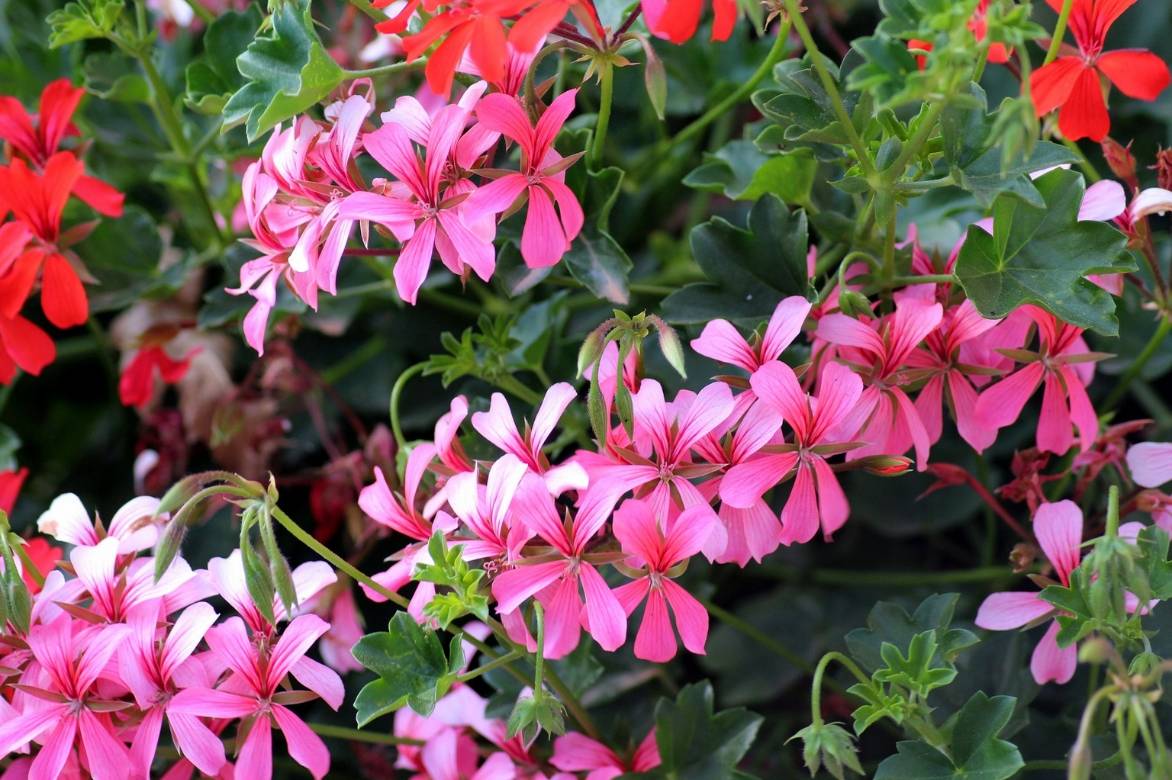
Pelargoniums come in numerous varieties such as the zonal pelargonium with velvety leaves marked by a darker zone, the ivy-leaved geranium (Pelargonium peltatum) “king of balconies”, which forms flowering cascades all summer long, the regal pelargonium with large flowers or the scented pelargonium like the Rose-scented Geranium (Pelargonium graveolens) whose foliage, rich in essential oils, releases varied fragrances of rose, lemon, mint or even chocolate depending on the cultivar, and is said to repel mosquitoes.
While the leaves of scented pelargoniums are edible, their roots are also used in herbal medicine for their purifying benefits.
It boasts long and generous flowering lasting 6 months of the year (or longer if kept warm in winter), ranging from pure white to the most vibrant red, only interrupted by the first autumn frosts.
Alternately elegant or verging on garish, it thrives in all gardens regardless of style, in flowerbeds, borders, rockeries, pots and hanging baskets.
Always beautiful whatever the weather, geranium flowers only require sunshine and regular watering.
From care to pruning, discover our advice and fall for our exceptional collection of pelargoniums as plug plants or our geranium seeds so easy to sow! So why deprive yourself?
Description and botany
Botanical data
- Latin name Pelargonium
- Family Geraniaceae
- Common name Pelargonium, Scented Geranium, Florist's Geranium, Balcony Geranium
- Flowering from April-May until autumn
- Height 0.15 to 1 m
- Exposure sun or partial shade
- Soil type All types, well-drained
- Hardiness frost-tender
The Pelargonium, better known as Geranium is a perennial plant or undershrub belonging to the geranium family.
Native to the mountainous regions of South Africa, the Pelargonium is not hardy in our climate where it is generally grown as an annual, on terraces or balconies, unlike its cousin the hardy geranium which is a hardy species that can remain in the ground in our gardens. The Pelargonium is incorrectly called “Geranium”. Geraniums and Pelargoniums are two distinct species, although they belong to the same family. However, the use of the name “geranium” to refer to pelargoniums has remained common.
The Pelargonium genus includes approximately 230 species and nearly 1,000 varieties. Many cultivars and hybrids have been obtained from about twenty species including Pelargonium grandiflorum, the florist’s pelargonium (Pelargonium x domesticum), Pelargonium graveolens or rose-scented geranium, the most fragrant of all used in perfumery, the origin of many hybrids, Pelargonium fragrans, with a pine scent, Pelargonium crispum, Pelargonium peltatum or ivy-leaved geranium, nicknamed the “King of Balconies” with a trailing habit.
Today, very few botanical pelargoniums are found as they have been extensively hybridised. Most cultivars fall into four main groups: ivy-leaved pelargoniums, with trailing stems very popular in hanging baskets or balcony boxes, zonal pelargoniums (Pelargonium x Hortorum), classic varieties with upright stems widely used in flower beds, “Regal” or large-flowered pelargoniums and scented pelargoniums or rose-scented geraniums, also called “Fragrant Geraniums”, whose leaves are aromatic.
There are also the “Unique” pelargoniums which are undershrubs that can reach 1 m in height in one season and whose foliage emits a strong spicy and pungent fragrance at the slightest touch.
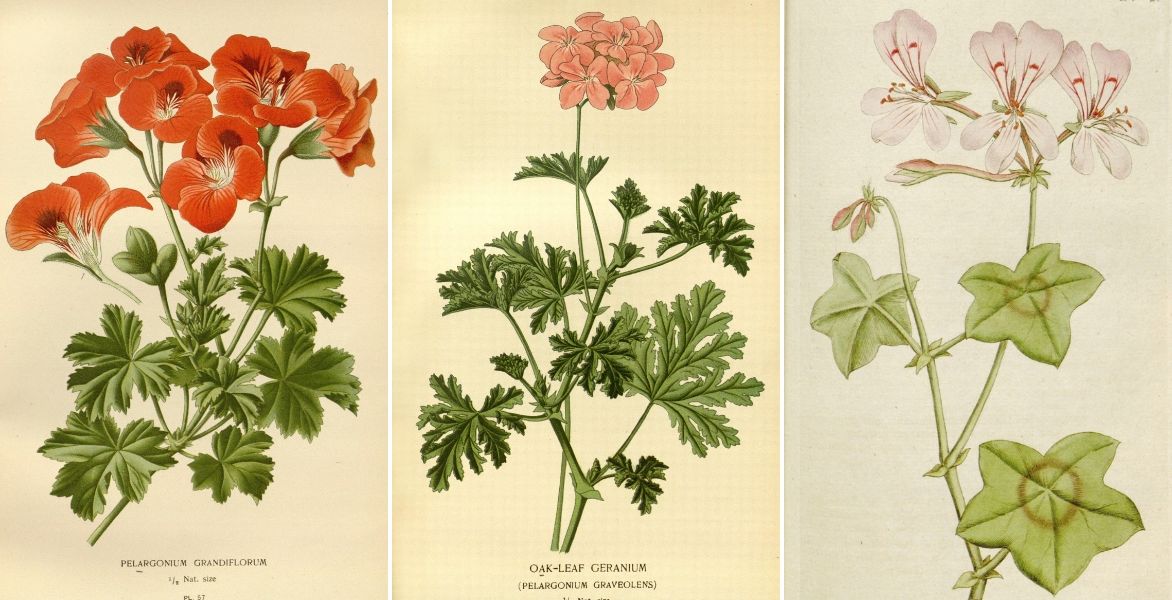
Botanical illustrations: Pelargonium grandiflorum / Pelargonium graveolens / Pelargonium peltatum
With rapid growth, the plant forms a bushy and dense clump, almost as wide as it is tall, with more or less significant development ranging from 0.10 cm in height for dwarf and miniature varieties to 1.20 m in height for the largest pelargoniums. Some geraniums resemble a small spreading shrub.
The habit varies according to the variety, upright in the case of the Zonal Geranium which forms a compact bush or very spreading and trailing in the famous ivy-leaved geranium. Its stems can reach 1m in length.
The branched stems bear leaves which also take various forms; alternate, fleshy, rounded, lobed or pointed, deeply veined, downy or glossy, they have toothed or undulate edges. The leaves are mostly evergreen in regions spared by winter frosts.
They are leathery, smooth and shiny, similar to those of ivy in the case of ivy-leaved pelargonium, rounded like fans, funnel-shaped in Pelargonium cucculatum and sometimes so lobed that they resemble those of maples.
They often have a long petiole, measure from 1 to 15 cm in diameter and display all shades of green: bright green in ivy-leaved varieties, medium green, soft green sometimes variegated with white-cream, gold or silver, or grey-green margined with red. They can be bicolour or tricolour. There are many varieties with decorative foliage such as ‘Mrs Pollock‘, ‘Vancouver appreciated by collectors.
The Zonal Geranium (and particularly the cultivars ‘Fantaisie’) is distinguished by its round leaves, very often zoned (hence its name “Zonal”), sometimes divinely margined with lighter shades and especially marked with coloured halos arranged in irregular and concentric circles of brown, dark bronze green, slate blue or black or in “butterfly wings”, with a distinct tone in the centre of the leaf.
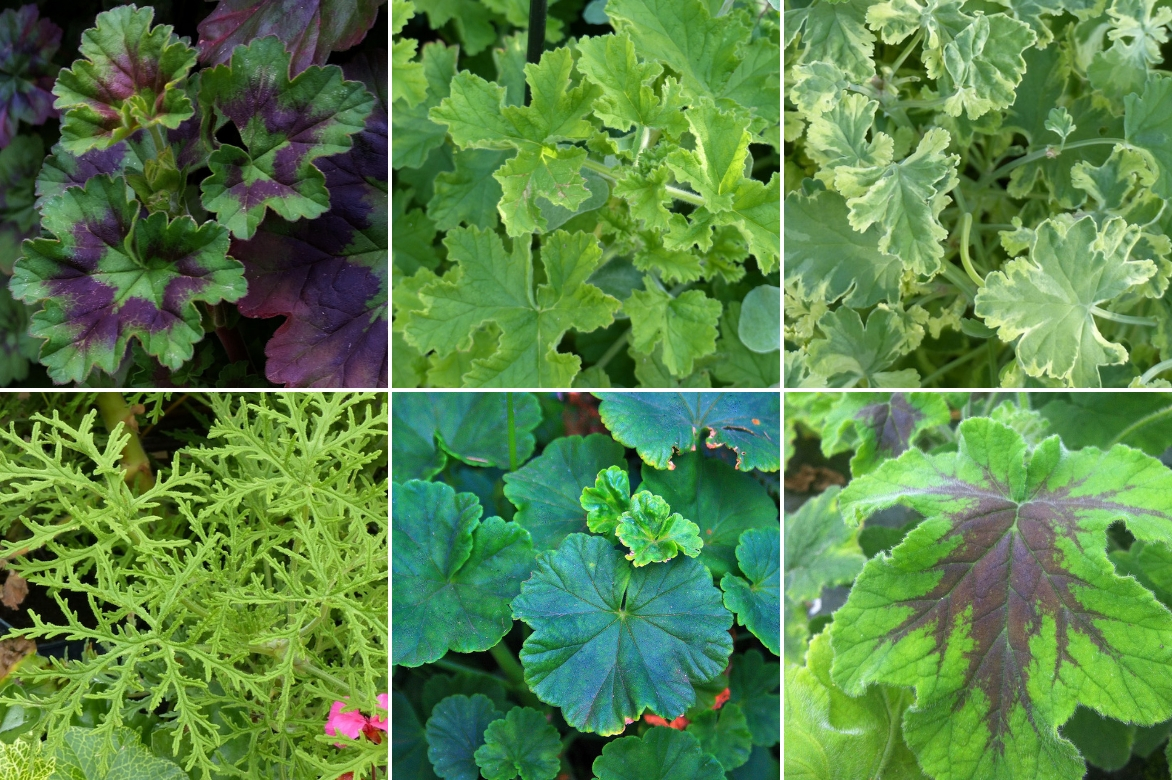
Diversity of foliage in Pelargoniums
The foliage of the scented pelargonium, rich in essential oils, is highly aromatic: its rougher or softer leaves, pleated, often deeply incised, release very varied fragrances when simply crushed of lemony rose, green apple, lemon, lemongrass, orange, mint, eucalyptus, pine in Pelargonium fragrans, spices and even hazelnut, chocolate or carrot! The pelargonium x graveolens and rose-scented pelargonium (P. capitatum), with a rose scent, are highly prized in perfumery.
This aromatic foliage is said to have the property of repelling mosquitoes.
Its edible leaves also flavour fruit salads.
Submerging the foliage, the flowering, often particularly long and abundant, appears from April to October depending on the species or all year round for plants kept between 10 and 15°C. The Pelargonium produces a mass of single, semi-double or double flowers as pretty in bud as when fully open.
At the end of the stems, the flowers grouped in terminal clusters in the form of umbels of varying sizes, renew themselves all summer long, contrasting well with the foliage.
Their shape differs according to the species: zonal pelargoniums have large flower heads, single or double, gathered in beautiful spherical clusters 5 to 13 cm in diameter that stand out clearly from the foliage, while ivy-leaved and scented geraniums produce countless smaller flowers gathered in looser and less imposing umbels. The flowering of pelargoniums with aromatic foliage, less spectacular, is more discreet and delicate.
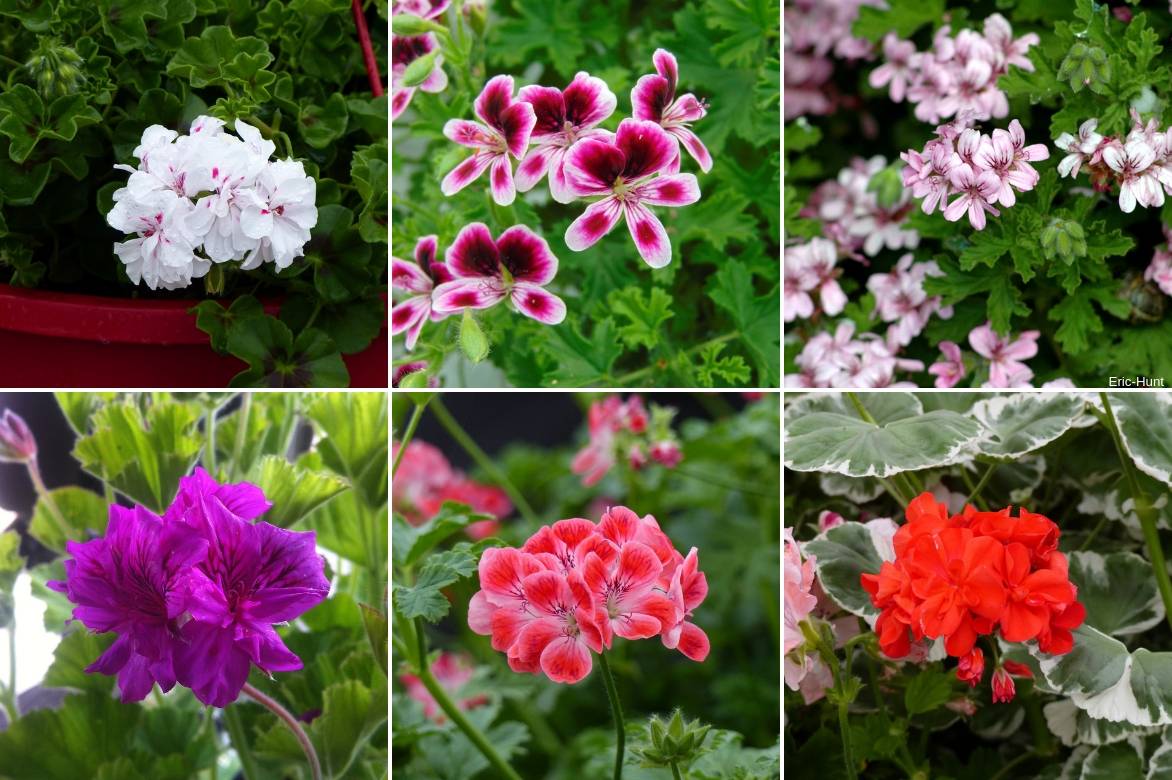

Some flowers: Pelargonium peltatum ‘Big 5 White Angel’, Pelargonium ‘Mosquitaway Eva’, Pelargonium graveolens, Pelargonium cucullatum, Pelargonium ‘Paton’s Unique’ and Pelargonium ‘Wilhelm Langguth’
The flowers, composed of at least 5 to 6 petals, are cup-shaped, star-shaped, trumpet-shaped, funnel-shaped or even butterfly-shaped (the two upper petals being larger than the three lower petals) and measure from 1 to 4 cm in diameter. Some resemble small roses (Pelargonium hortorum ‘Appleblossom’) or even cactus dahlias with twisted and curled petals, or are made up of thin, pointed petals with a serrated edge (Fireworks ‘Scarlet‘).
Variable in colour, the summer flowering is not limited to the traditional bright red geranium, but comes in solid or multicoloured shades, bright, rare, deep or pastel ranging from burgundy-wine, fresh pink, mauve, purple, pure white, more rarely yellow to salmon orange. These bright or velvety colours do not fade in the sun.
Some petals are veined, variegated with subtle bicolour shades, sometimes tricolour, showing small more or less contrasting spots.
After flowering, the flowers give way to fruits whose very elongated shape resembles a bird’s beak, hence the name “pelargonium” which in Greek means “Stork”.
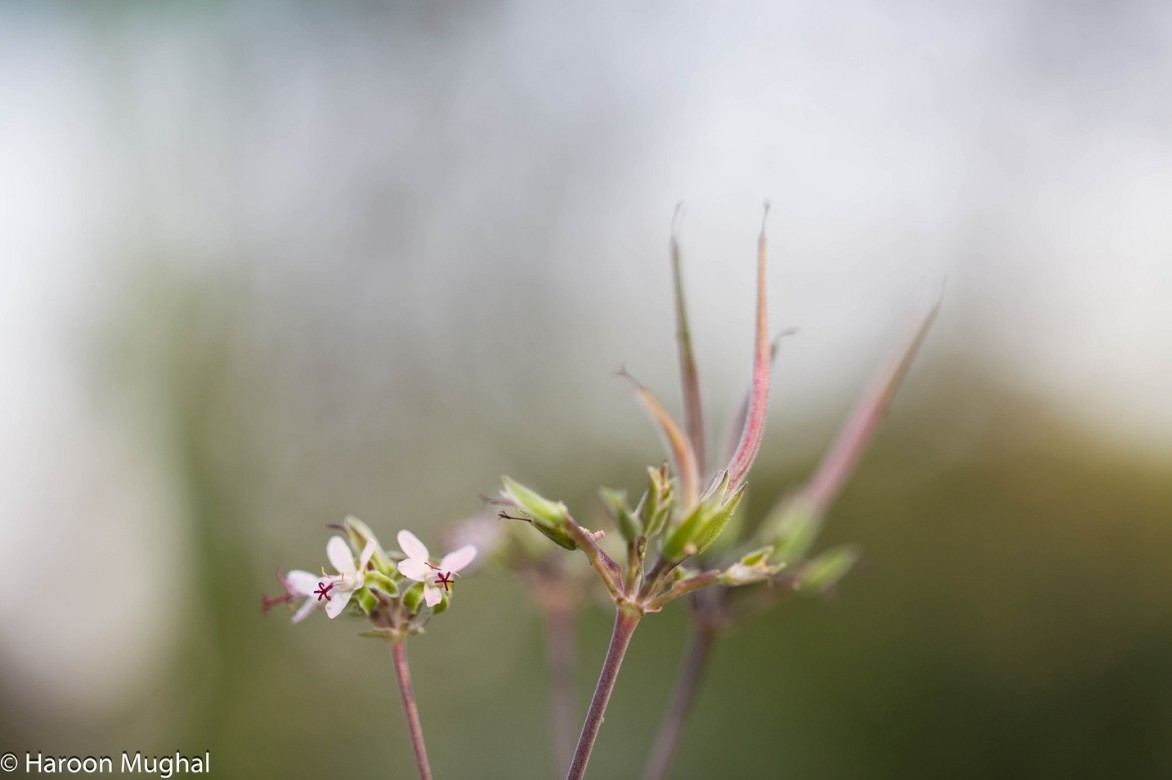
Typical fruits shaped like a bird’s beak
The flower of the scented pelargonium, slightly fragrant, is edible and can enhance summer desserts such as sorbets.
Not hardy, the pelargonium is somewhat tender and needs to be brought into a greenhouse in regions with cold winters. Drought-resistant, it grows quickly in light, well-drained and fertile soils, in full sun or preferably in partial shade in hot regions.
The geranium is the essential annual plant in summer displays, to add height and colour to flower beds, borders and sunny edges, as well as in hanging baskets and planters on terraces, balconies or conservatories.
For centuries, pelargonium root has been used in herbal medicine for its benefits and medicinal properties as a cleanser against symptoms of breathing infections such as bronchitis.
Main species and varieties
It’s not always easy to navigate among the 230 species of pelargoniums! First, you need to distinguish between the Pelargonium, which is frost-tender and grown in our regions as an annual, and the hardy perennial Geranium, which is hardy and can remain in the ground for years in the garden.
The pelargonium is mistakenly called “geranium”. It was the botanist Carl Von Linne who, in 1787, grouped Pelargoniums and Geraniums under the same genus. Some 25 years later, the French botanist L’Héritier noticed the error and created the genus Pelargonium. Too late! The mistake persisted for a long time… These two plants do indeed belong to the same family, the Geraniaceae, but that is their only common feature!
We can distinguish several groups of pelargoniums, within which numerous cultivars have been created. Not to mention the hybrids! They are suited to every use and come in a multitude of colours, offering a great diversity of textures and fragrances!
- The zonal pelargonium (30 to 50 cm tall): This is the classic geranium, forming colourful clumps with its upright stems, its beautiful round, velvety leaves marked with a contrasting halo zone and its large flower heads in all shades of red, pink and white, plain or bicoloured. It belongs to the large group of Pelargonium x hortorum hybrids. It is used in borders and planters.
- The ivy-leaved pelargonium (up to 1m tall): This is the “king of balconies”, the most commonly used in pots, hanging baskets or containers. It forms cascades of trailing or creeping flowers. Its bright green, glossy leaves resemble ivy.
- The Scented-leaved pelargonium: Its flowering is more discreet, its rough or velvety foliage is sometimes variegated with yellow or silver, and above all, it releases varied scents of apple, mint, spices, lemon or even orange when crushed. P. x graveolens and P. capitatum emit a rose fragrance, widely used in perfumery.
- The regal pelargonium or large-flowered pelargonium (Pelargonium grandiflorum): Also known as “Regal” pelargonium. It resembles the zonal geranium but has serrated leaves and much larger inflorescences. It is often grown indoors or in greenhouses.
Discover our unique collection of geraniums as plug plants or as seeds, including some exclusive varieties!
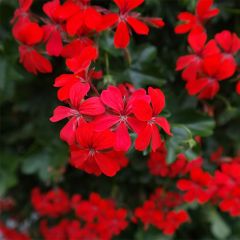
Pelargonium peltatum Balcon Imperial Red
- Flowering time June to December
- Height at maturity 20 cm
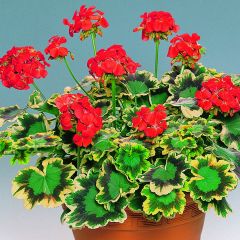
Pelargonium Brocade Mrs Pollock
- Flowering time June to November
- Height at maturity 45 cm
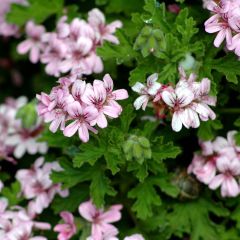
Pelargonium graveolens
- Flowering time July to October
- Height at maturity 60 cm
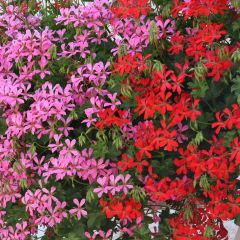
Collection of 10 Red and Pink Balcony Geraniums
- Flowering time August to December
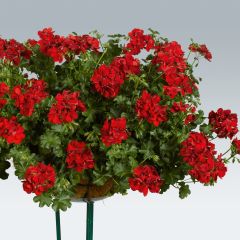
Pelargonium peltatum Ruby
- Flowering time July to December
- Height at maturity 50 cm
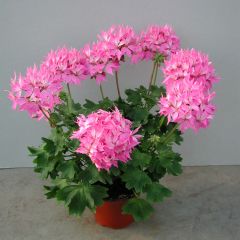
Pelargonium hortorum Fireworks Pink
- Flowering time June to November
- Height at maturity 40 cm
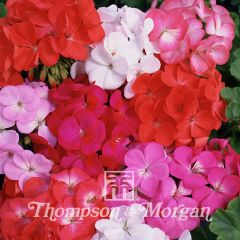
Pelargonium Border Supreme F2 Seeds - Geranium
- Flowering time August to November
- Height at maturity 35 cm
Pelargonium hortorum Flower Fairy Velvet
- Flowering time June to November
- Height at maturity 35 cm
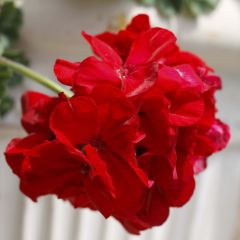
Pelargonium Cassiopeia
- Flowering time June to November
- Height at maturity 50 cm

Pelargonium Blanche Roche - Ivy Geranium
- Flowering time June to December
- Height at maturity 20 cm
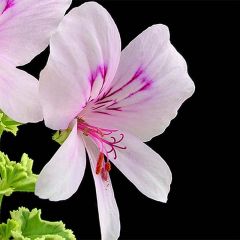
Pelargonium crispum Variegatum
- Flowering time July to October
- Height at maturity 80 cm
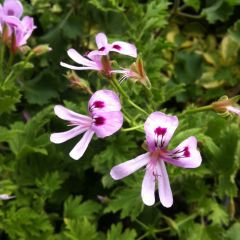
Pelargonium Lemon fancy
- Flowering time July to October
- Height at maturity 60 cm
Discover other Pelargonium - Geranium
View all →Available in 1 sizes
Available in 1 sizes
Available in 1 sizes
Available in 1 sizes

Available in 1 sizes
Available in 1 sizes
Available in 1 sizes
Available in 2 sizes
Available in 1 sizes
Available in 1 sizes
Planting
Where to Plant a Pelargonium or Geranium?
The pelargonium is a plant native to South Africa, sensitive to frost and therefore somewhat tender in our climate. Below 0°C, the pelargonium will not survive.
If it can remain in the ground in mild coastal climates and regions spared from severe frosts, retaining its foliage even in winter, it will simply need to be stored in a cold greenhouse or conservatory at a minimum temperature of 10°C, or grown as an annual plant elsewhere. This way, you can keep it from year to year by overwintering it frost-free and bringing the pots back out in the warmer months.
Note, however, that Elisabeth, our Mediterranean climate specialist, grows a Pelargonium quercifolium in the ground. It has been thriving for 5 or 6 years, stands over 1 metre tall, and vigorously regrows from the stump if slightly frost-damaged. And she never waters it!
Adaptable to soil conditions, naturally resistant to summer drought, and unfazed by bad weather, while it thrives in well-drained soil, it performs best in rich, light soil.
From its South African origins, it retains a preference for sun and warmth. It enjoys full sun or partial shade in southern France.
You can plant your pelargoniums in the ground or in pots.
With its decorative, sometimes fragrant foliage and abundant flowering, the Pelargonium is a must-have in summer compositions, whether romantic, vibrant, or chic. It’s ideal for natural gardens.
Not hardy, it is the star annual plant of summer displays, offering ephemeral charm to be recreated each year as desired. Long reserved for hanging baskets and window boxes on windowsills, balconies, and terraces, the pelargonium now graces flower beds, borders, and sunny borders, quickly adding a cheerful, colourful touch throughout the season.
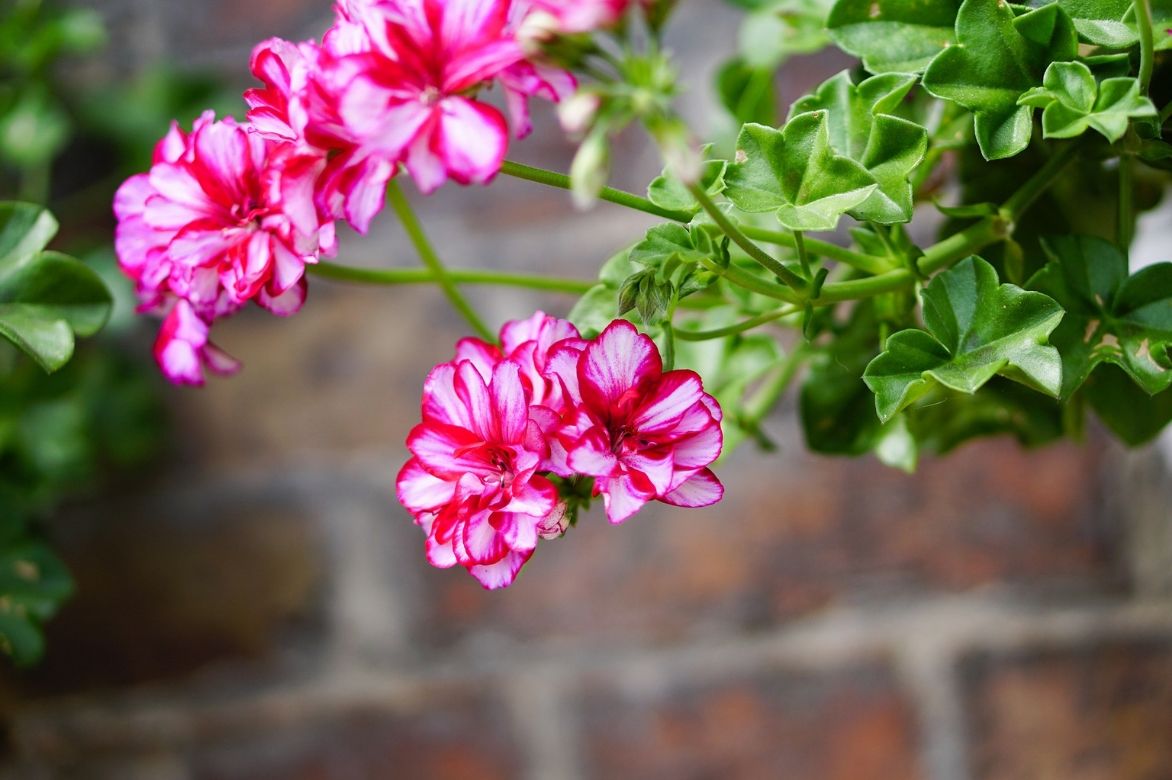
The trailing ivy-leaved geraniums form cascading blooms perfect for hanging baskets and rockeries and make excellent ground cover. They can also be trained on a trellis against a wall, outdoors or in a winter garden.
The zonal geranium grows in compact, colourful clumps and is perfect for flower beds, pots, and borders.
The scented geraniums work wonders as a low hedge or border along a path or in a large pot on the terrace or in a conservatory, never too far from the house to enjoy their fragrance.
Finally, all are well-suited to greenhouse cultivation.
When to Plant a Pelargonium or Geranium?
Planting pelargoniums or geraniums takes place in spring, but timing varies by region. In mild climates, you can plant our plug plant pelargoniums as early as March-April. Wait until mid-May in northern regions to plant them outdoors. Meanwhile, you can pre-grow them in pots in a warm, bright spot to accelerate growth.
In all cases, upon receipt, transplant and store them under cover (conservatory, greenhouse…) at a temperature above 14°C and wait until the risk of frost has passed and the soil has warmed up before planting or moving them outside.
How to Plant a Pelargonium?
- In the ground
For a vibrant mass effect, opt for group planting. Allow for 5 to 7 plants per m² and space them 20 cm apart. It needs light, humus-bearing, and well-draining soil. Always add gravel to soil where water tends to pool.
- Loosen the soil well
- Dig a hole two to three times the size of the plug plant
- Position the plug plant and cover it lightly, adding some leaf mould
- Firm gently without damaging the young plant
- Water thoroughly
More tips on planting annuals as plug plants on our blog!
- Planting geraniums in pots or containers
All geraniums reign supreme in hanging baskets, containers, and pots, but ivy-leaved geraniums are the most popular. Use a well-draining mix to avoid waterlogged roots. Don’t hesitate to mix varieties for lively, floriferous displays!
- Place a generous layer of drainage (gravel, pottery shards, or clay pebbles) at the base of a pierced container
- Plant in a “geranium” compost mix or a blend of garden soil and potting compost
- Position in full sun
- Water regularly, never letting the substrate dry out between waterings—keep the compost moist but not waterlogged
- Move potted pelargoniums outside after the last frost
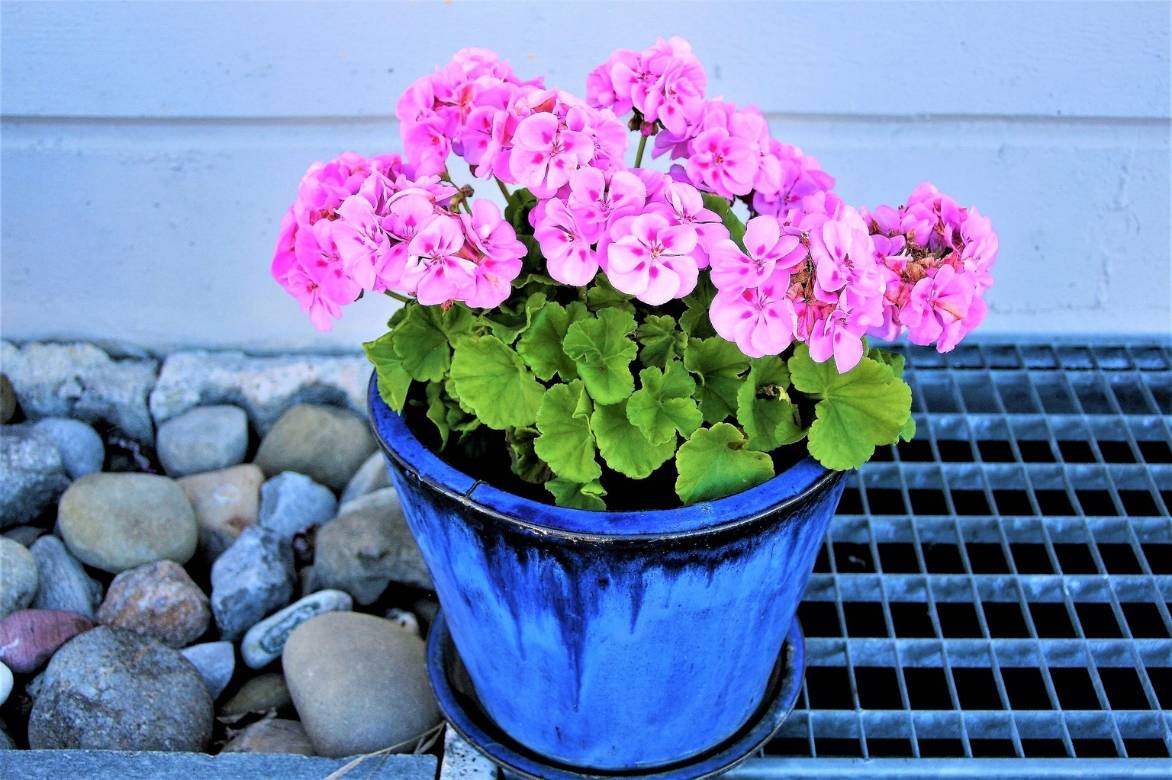
When and how to sow pelargonium or geraniums?
Sowing pelargonium seeds should be done under cover from mid-January to mid-March. The young plants will be transplanted outdoors into open ground once all risk of frost has passed. They will flower in the same year as sowing.
How to successfully sow geranium seeds
- Sow geranium seeds 2 cm apart without burying them, in a tray filled with special sowing compost
- Cover with 1 or 2 mm of compost
- Place them in a warm spot with a minimum temperature of 18°C, ideally 20-25°C
- Keep the compost moist but not waterlogged
- Germination occurs within 10 to 15 days
- When they reach the 4-leaf stage, transplant the young plants into individual pots or buckets
- In mid-May after all risk of frost, transplant them into the ground, pots or planters
- Pinch out the tips of rooted cutting stems early to encourage branching
Discover our tips for successfully sowing annual seeds! and our advice sheet on pelargonium propagation by cuttings
Maintenance, pruning and care
The Pelargonium is a highly floriferous annual that grows without requiring much care.
In open ground, it tolerates lack of water quite well: water only during the first few weeks after planting.
Potted geraniums should be watered one to three times a week but without excess, as soon as the soil surface dries out: the substrate should remain moist.
Potted geraniums are greedy plants that require weekly applications of liquid fertiliser “geranium”, from April to August, to promote continuous growth and flowering.
Remove all the first flower buds and pinch the tips of young plants to encourage branching.
Regularly cut back faded flowers and yellowed foliage to encourage new flowers and extend the flowering period.
Pelargoniums cannot tolerate frost. In autumn, uproot plants grown in open ground, discard them or replant them temporarily in pots of the same size or slightly smaller.
Bring pots indoors in a cool but bright place kept frost-free, to preserve them from one year to the next.
→ Learn more about winter care for Pelargoniums in our tutorial!
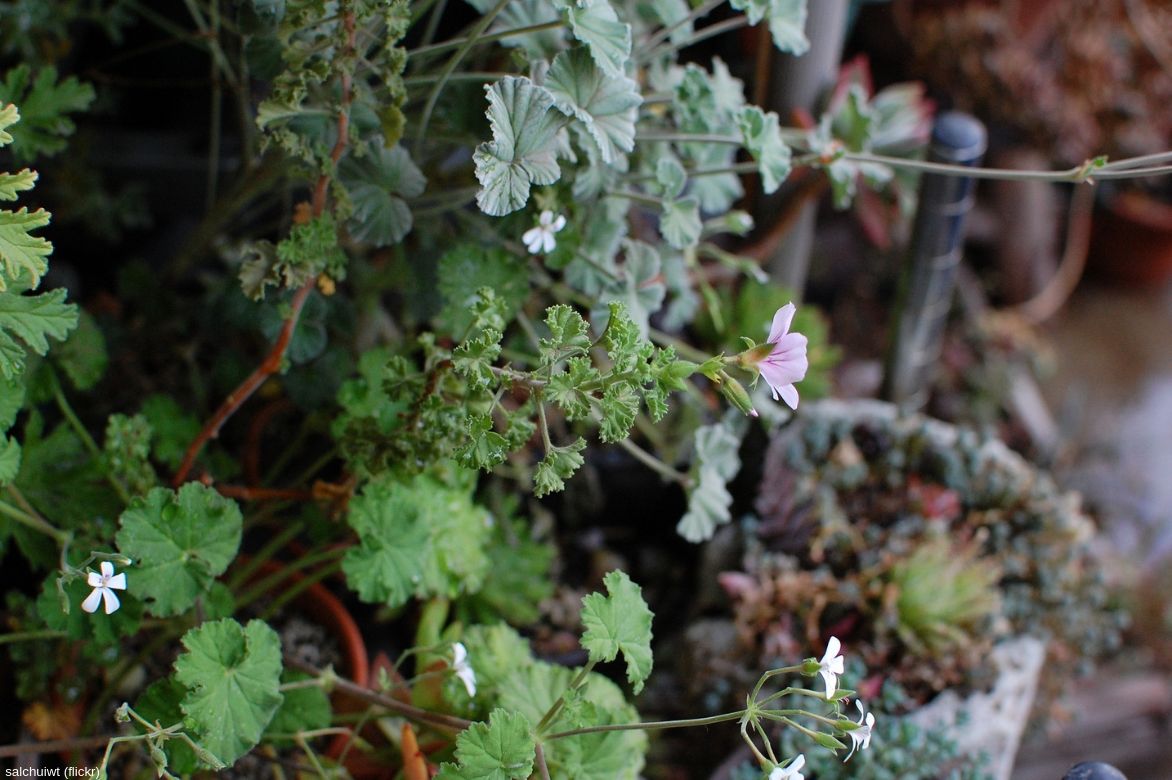
How to keep geraniums over winter?
Pelargoniums or geraniums can continue to flower throughout winter if kept between 7 and 10°C in a bright room. To learn all about overwintering them, visit our advice sheet: Successful overwintering of Pelargoniums (Balcony Geraniums)
Diseases and potential pests
The pelargonium is susceptible to certain diseases and pests.
Cold and excess water can cause grey mould (botrytis) of the roots and base of the stems (blackleg). Zonal pelargoniums are sensitive to rust. In both cases, burn the affected leaves and treat if still possible with Bordeaux mixture.
Against whiteflies (aleurodes), shower the foliage and keep slugs away naturally with our advice.
Its stems can also fall prey to the green caterpillar of a small brown butterfly called “geranium bronze”, quickly leading to the death of the young plant. Cut off all affected stems.
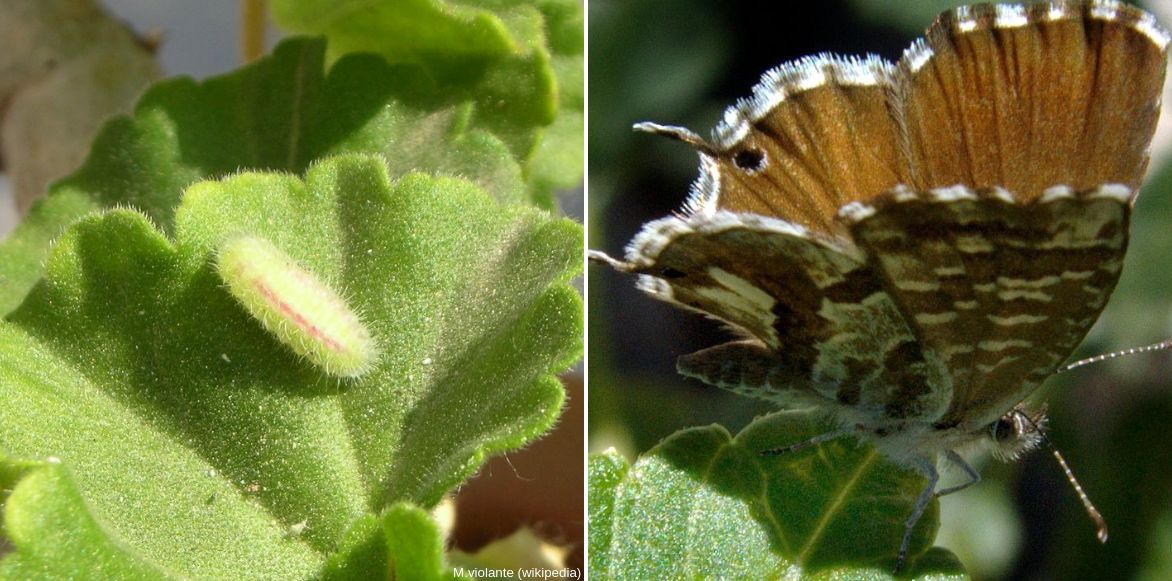
Caterpillar and butterfly of the Geranium Bronze (Cacyreus marshalli)
Also watch out for aphids which can invade it: shower the plants with soapy water to dislodge them.
More details can be found in our article: Diseases and pests of pelargoniums.
Propagation
The pelargonium or geranium can be easily propagated by cuttings. Cuttings taken in late summer will flower as early as the following spring.
When and how to take geranium cuttings?
In July-August, choose a healthy pelargonium and take several cuttings.
- Using secateurs, cut below a node, a stem without flowers about 10 cm long
- Remove all lower leaves, keeping only the top two leaves
- Cut the base at an angle and make an incision with a sharp knife
- Plant in a perforated tray (you can also place the cuttings in individual buckets) containing a mix of turf and sand, burying the cuttings halfway and spacing them 10 cm apart
- Water generously
- Close the container with a lid or plastic bag
- Keep moist throughout winter, in a dry and well-lit room heated to 12-15°C
- At the end of winter, transplant them into individual buckets
- Plant in the ground or move pots outdoors by mid-May
→ Read also: How to take cuttings from pelargonium or balcony geraniums?
Pairing pelargoniums
With their bright or pastel colours, Pelargoniums or geraniums cater to every desire, whether planted in the ground or in pots to create often very colourful and cheerful displays throughout the summer season.
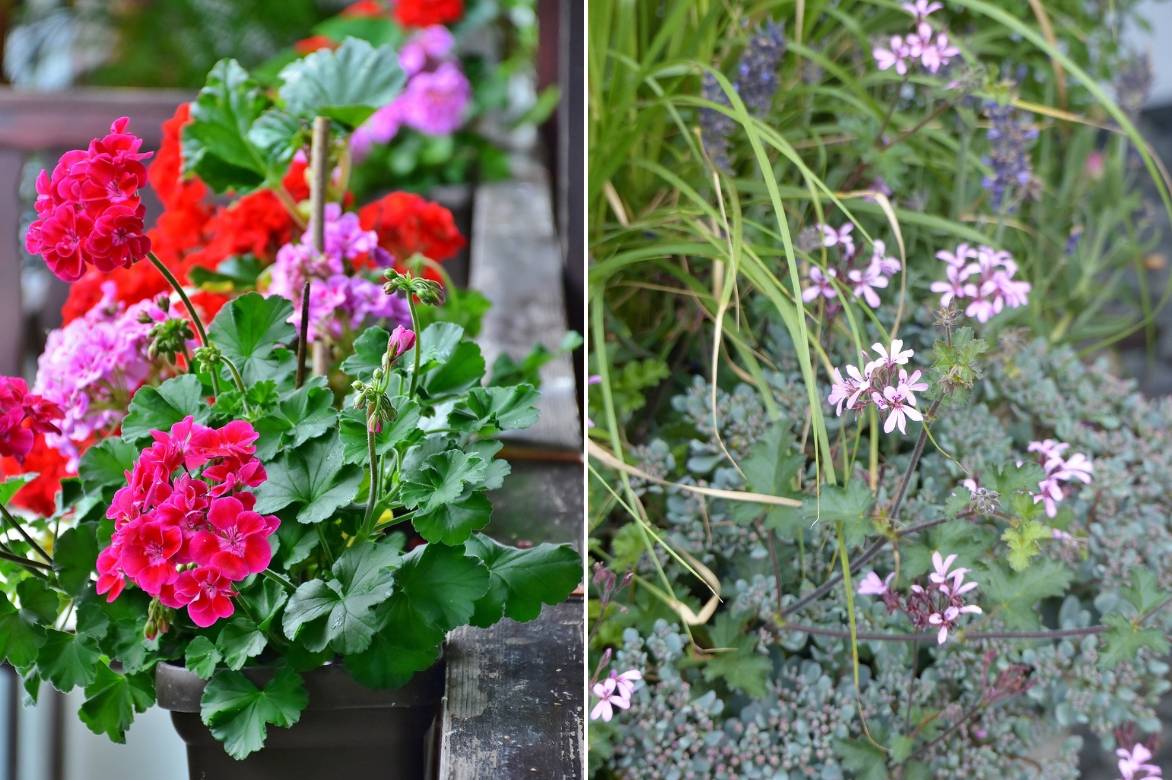
Examples of uses: in brightly coloured planters or in pastel-toned flower beds with Liriope muscari ‘Ingwersen’ or ornamental grasses like Carex and ground-covering Sedums such as ‘Cape Blanco’, ‘Purpureum’, ‘Album Superbum’, sieboldii, etc
They come in an infinite variety of colours allowing for endless combinations, whether in gradients or monochrome, elegant and chic or vibrant! They adapt to all garden styles, from the most romantic to the most naturalistic.
They thrive alongside many summer flowers, whether annual or perennial.
In a refined summer border, pair zonal geraniums with white or pearly pink flowers with purple ageratum, Verbena bonariensis, and dense clumps of small mealy sage.
In a multicoloured flower bed, mix geraniums with dwarf dahlias and French marigolds (which will protect them from whiteflies).
They also pair beautifully with plants that have a lighter silhouette, such as cleomes, catmints, flowering tobacco and cosmos.
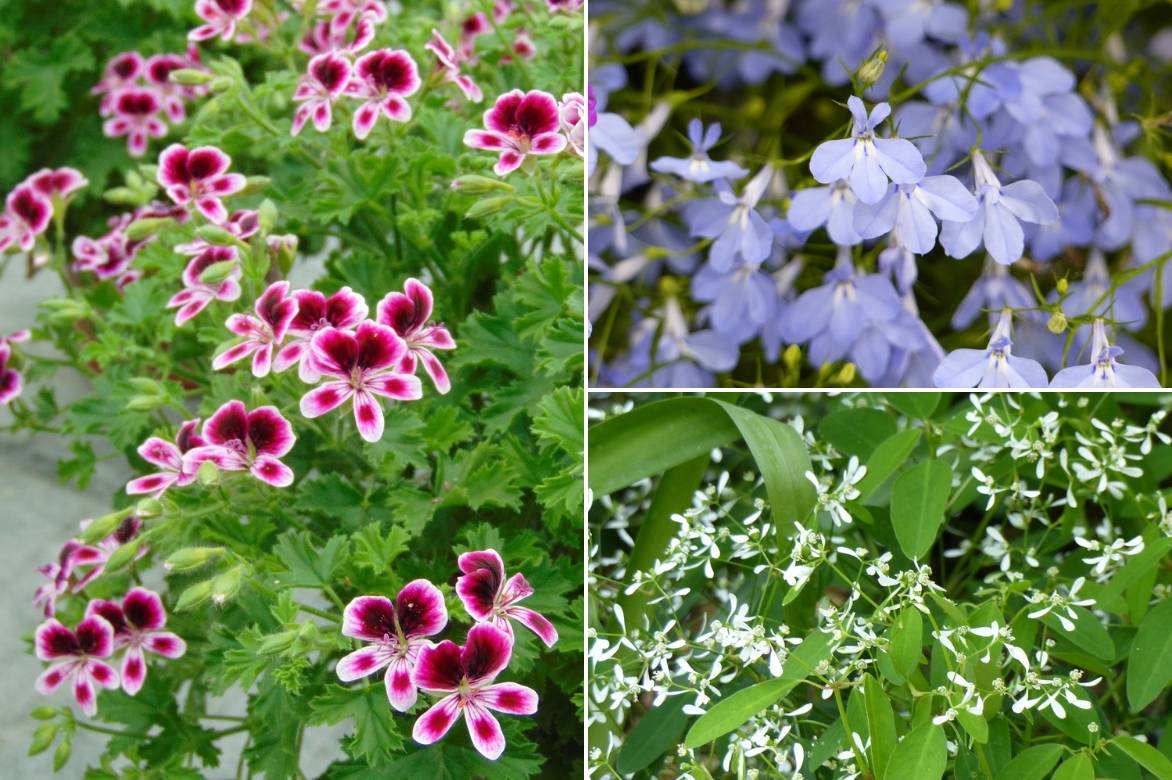

A combination idea: Pelargonium ‘Mosquitaway Eva’, Lobelia ‘Hot Water Blue’ and Chamesyce hypericifolia ‘Diamond Frost’
Paired with petunias, ivy-leaved geraniums will conceal the bare base of a shrub rose throughout the summer season.
Along the edge of a colourful summer flower bed, pelargonium flowers combine beautifully with the contrasting blooms of zinnias, rudbeckias, and the spiky silhouettes of phormiums and cordylines.
The intense scarlet colour of geraniums pairs well with bronze or purple foliage from heucheras, castor bean plants, dahlias and tall cannas.
You can also intersperse them to punctuate borders of grey-foliaged plants like snow-in-summer, Helichrysum, dusty miller or artemisias.
Ivy-leaved geraniums can be trained against a conservatory wall, alongside other climbing annuals like morning glories and ipomoeas.
Create stunning container displays and hanging baskets by combining them with Calibrachoa ‘Million Bells’, Bacopa, lobelias or scaevolas.
Useful resources
- Discover our scented geraniums: their foliage releases fragrances of rose, lemon, mint, spices and even carrot, capable of driving away a squadron of mosquitoes!
- Whether ivy-leaved, zonal or scented, Geraniums or Pelargoniums are generous plants, stars of our gardens, terraces and balconies during the summer season – don’t miss out!
- With their romantic or vibrant colours, they’re essential for creating “Happy” scenes throughout the fine season, perfect for a pink garden, Catalan-inspired designs or simply a white garden!
- Discover our 7 pairing ideas for beautiful summer planters
- Guide: 10 fragrant pelargoniums
- Tutorial: How to prune a Pelargonium?
Frequently asked questions
-
Why are the leaves of my geraniums turning yellow?
Not too much, not too little! That could be the golden rule when it comes to watering geraniums. In case of water shortage, the leaves turn yellow and fall off, whereas overwatering can harm flowering and the plant's health, as the roots may rot. Geraniums thrive best in light, well-drained, airy and rich compost, whether in the garden or in pots. For potted pelargoniums, water once a week. Potted pelargoniums are quite demanding, and if they lack fertiliser, the foliage may also turn yellow. Remember to feed them well throughout the growth period.
- Subscribe!
- Contents
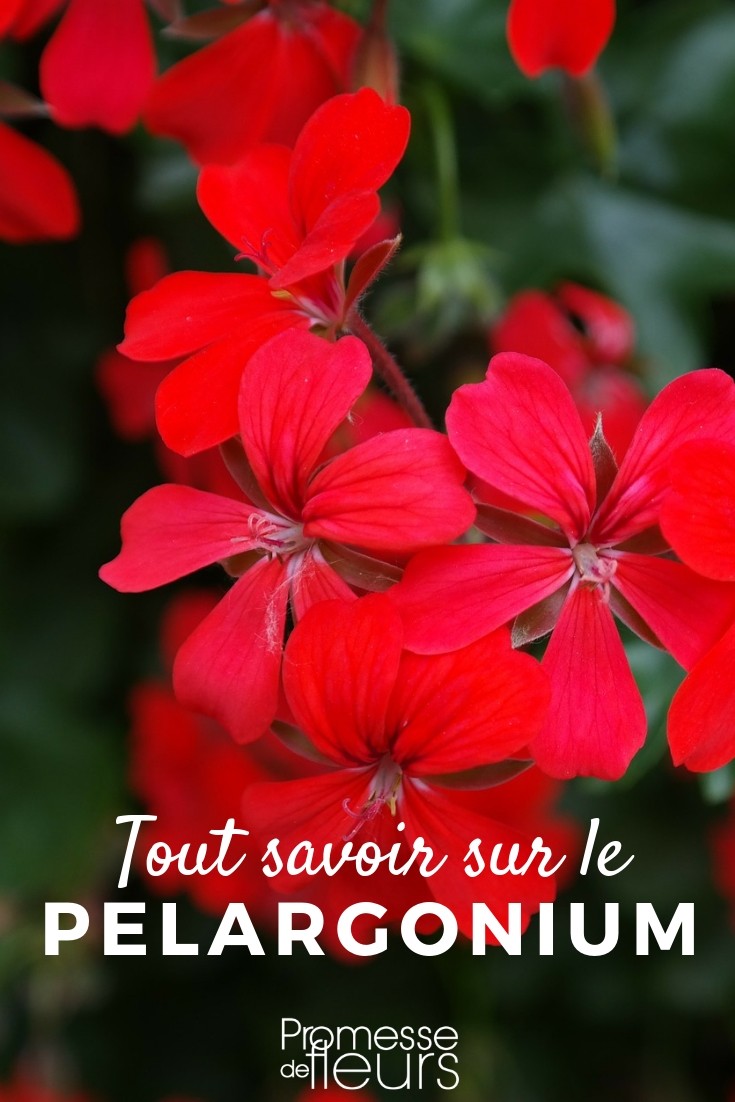



































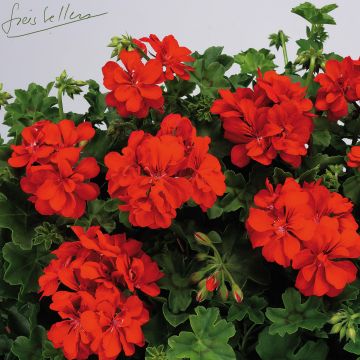
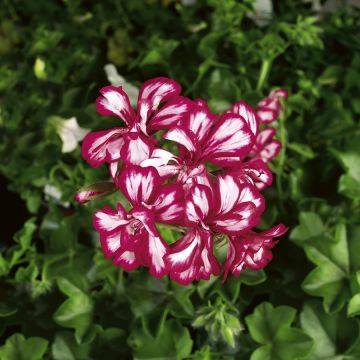
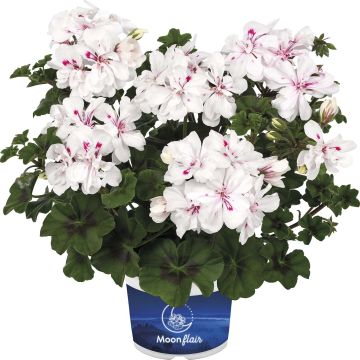
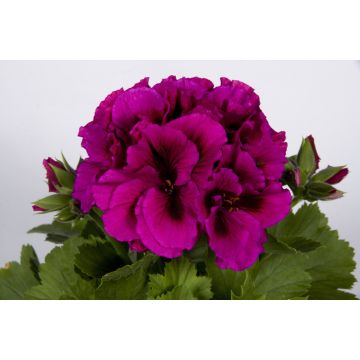
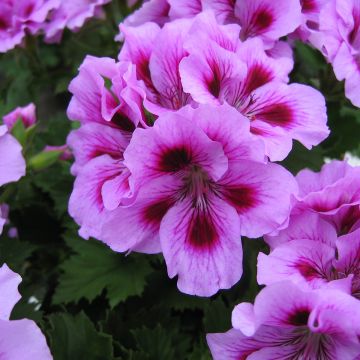
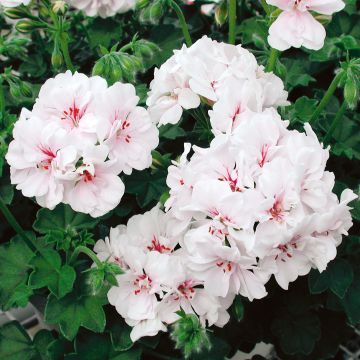

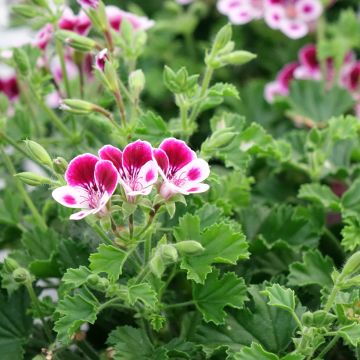
Comments